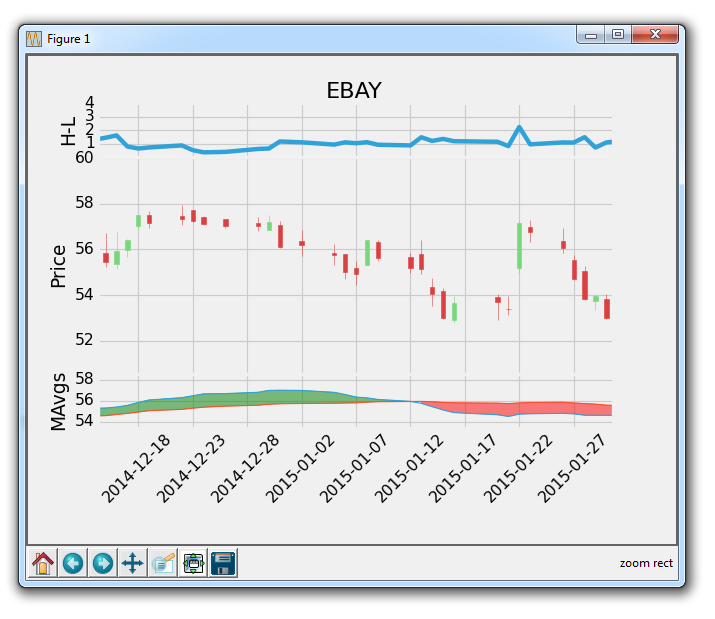第二十三章 共享 X 轴
原文:Share X Axis, sharex, with Matplotlib
译者:飞龙
在这个 Matplotlib 数据可视化教程中,我们将讨论sharex选项,它允许我们在图表之间共享x轴。将sharex看做『复制 x』也许更好。
在我们开始之前,首先我们要做些修剪并在另一个轴上设置最大刻度数,如下所示:
ax2.yaxis.set_major_locator(mticker.MaxNLocator(nbins=7, prune='upper'))
以及
ax3.yaxis.set_major_locator(mticker.MaxNLocator(nbins=4, prune='upper'))
现在,让我们共享所有轴域之间的x轴。 为此,我们需要将其添加到轴域定义中:
fig = plt.figure()
ax1 = plt.subplot2grid((6,1), (0,0), rowspan=1, colspan=1)
plt.title(stock)
plt.ylabel('H-L')
ax2 = plt.subplot2grid((6,1), (1,0), rowspan=4, colspan=1, sharex=ax1)
plt.ylabel('Price')
ax3 = plt.subplot2grid((6,1), (5,0), rowspan=1, colspan=1, sharex=ax1)
plt.ylabel('MAvgs')
上面,对于ax2和ax3,我们添加一个新的参数,称为sharex,然后我们说,我们要与ax1共享x轴。
使用这种方式,我们可以加载图表,然后我们可以放大到一个特定的点,结果将是这样:

所以这意味着所有轴域沿着它们的x轴一起移动。 这很酷吧!
接下来,让我们将[-start:]应用到所有数据,所以所有轴域都起始于相同地方。 我们最终的代码为:
import matplotlib.pyplot as plt
import matplotlib.dates as mdates
import matplotlib.ticker as mticker
from matplotlib.finance import candlestick_ohlc
from matplotlib import style
import numpy as np
import urllib
import datetime as dt
style.use('fivethirtyeight')
print(plt.style.available)
print(plt.__file__)
MA1 = 10
MA2 = 30
def moving_average(values, window):
weights = np.repeat(1.0, window)/window
smas = np.convolve(values, weights, 'valid')
return smas
def high_minus_low(highs, lows):
return highs-lows
def bytespdate2num(fmt, encoding='utf-8'):
strconverter = mdates.strpdate2num(fmt)
def bytesconverter(b):
s = b.decode(encoding)
return strconverter(s)
return bytesconverter
def graph_data(stock):
fig = plt.figure()
ax1 = plt.subplot2grid((6,1), (0,0), rowspan=1, colspan=1)
plt.title(stock)
plt.ylabel('H-L')
ax2 = plt.subplot2grid((6,1), (1,0), rowspan=4, colspan=1, sharex=ax1)
plt.ylabel('Price')
ax3 = plt.subplot2grid((6,1), (5,0), rowspan=1, colspan=1, sharex=ax1)
plt.ylabel('MAvgs')
stock_price_url = 'http://chartapi.finance.yahoo.com/instrument/1.0/'+stock+'/chartdata;type=quote;range=1y/csv'
source_code = urllib.request.urlopen(stock_price_url).read().decode()
stock_data = []
split_source = source_code.split('\n')
for line in split_source:
split_line = line.split(',')
if len(split_line) == 6:
if 'values' not in line and 'labels' not in line:
stock_data.append(line)
date, closep, highp, lowp, openp, volume = np.loadtxt(stock_data,
delimiter=',',
unpack=True,
converters={0: bytespdate2num('%Y%m%d')})
x = 0
y = len(date)
ohlc = []
while x < y:
append_me = date[x], openp[x], highp[x], lowp[x], closep[x], volume[x]
ohlc.append(append_me)
x+=1
ma1 = moving_average(closep,MA1)
ma2 = moving_average(closep,MA2)
start = len(date[MA2-1:])
h_l = list(map(high_minus_low, highp, lowp))
ax1.plot_date(date[-start:],h_l[-start:],'-')
ax1.yaxis.set_major_locator(mticker.MaxNLocator(nbins=4, prune='lower'))
candlestick_ohlc(ax2, ohlc[-start:], width=0.4, colorup='#77d879', colordown='#db3f3f')
ax2.yaxis.set_major_locator(mticker.MaxNLocator(nbins=7, prune='upper'))
ax2.grid(True)
bbox_props = dict(boxstyle='round',fc='w', ec='k',lw=1)
ax2.annotate(str(closep[-1]), (date[-1], closep[-1]),
xytext = (date[-1]+4, closep[-1]), bbox=bbox_props)
## # Annotation example with arrow
## ax2.annotate('Bad News!',(date[11],highp[11]),
## xytext=(0.8, 0.9), textcoords='axes fraction',
## arrowprops = dict(facecolor='grey',color='grey'))
##
##
## # Font dict example
## font_dict = {'family':'serif',
## 'color':'darkred',
## 'size':15}
## # Hard coded text
## ax2.text(date[10], closep[1],'Text Example', fontdict=font_dict)
ax3.plot(date[-start:], ma1[-start:], linewidth=1)
ax3.plot(date[-start:], ma2[-start:], linewidth=1)
ax3.fill_between(date[-start:], ma2[-start:], ma1[-start:],
where=(ma1[-start:] < ma2[-start:]),
facecolor='r', edgecolor='r', alpha=0.5)
ax3.fill_between(date[-start:], ma2[-start:], ma1[-start:],
where=(ma1[-start:] > ma2[-start:]),
facecolor='g', edgecolor='g', alpha=0.5)
ax3.xaxis.set_major_formatter(mdates.DateFormatter('%Y-%m-%d'))
ax3.xaxis.set_major_locator(mticker.MaxNLocator(10))
ax3.yaxis.set_major_locator(mticker.MaxNLocator(nbins=4, prune='upper'))
for label in ax3.xaxis.get_ticklabels():
label.set_rotation(45)
plt.setp(ax1.get_xticklabels(), visible=False)
plt.setp(ax2.get_xticklabels(), visible=False)
plt.subplots_adjust(left=0.11, bottom=0.24, right=0.90, top=0.90, wspace=0.2, hspace=0)
plt.show()
graph_data('EBAY')
下面我们会讨论如何创建多个y轴。